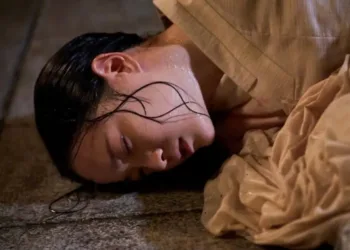Lynne Ramsay’s Die My Love delivers one of 2025’s most devastating film endings. Starring Jennifer Lawrence as Grace, a new mother spiraling into postpartum crisis, the film concludes with an ambiguous yet haunting scene that leaves audiences asking: Did Grace die in that forest fire? While never explicitly shown, the evidence overwhelmingly suggests a tragic answer.
Table of Contents
Die My Love Grace’s Descent Into Darkness
Adapted from Ariana Harwicz’s 2012 novel and nominated for the Palme d’Or at Cannes Film Festival, Die My Love chronicles Grace’s psychological unraveling after relocating from New York to rural Montana with partner Jackson (Robert Pattinson) and their newborn.
| Character | Actor | Role | Impact on Grace |
|---|---|---|---|
| Grace | Jennifer Lawrence | New Mother | Suffers severe postpartum depression and isolation |
| Jackson | Robert Pattinson | Partner | Unable to communicate, relationship deteriorates |
| Pam | Sissy Spacek | Jackson’s Mother | Offers inadequate support despite good intentions |
| Neighbor | LaKeith Stanfield | Obsession Object | Represents Grace’s desperate need for external connection |
The film portrays postpartum depression with brutal honesty—agitation, impulsive behavior, withdrawal, and emotional volatility escalate throughout. Grace’s deterioration stems not from rejecting motherhood (she’s shown as loving toward her son) but from crushing isolation and insufficient support systems.

The Final Act: Walking Into Flames
The ending arrives without warning or salvation. Grace burns her writings in the forest, then walks deliberately into the flames she created. The screen cuts to black. No escape scene. No rescue. No survival indication.
Director Lynne Ramsay’s realistic visual language throughout the film makes this final act unmistakable. The fire isn’t symbolic—it’s literal. Grace’s absence afterward confirms what the staging implies: she chose death over continuing her unbearable existence.
According to maternal mental health resources from Postpartum Support International, untreated postpartum depression can lead to tragic outcomes when mothers lack adequate intervention and support. Die My Love unflinchingly portrays this reality without romanticizing or softening the blow.
Why the Ambiguity Matters
Ramsay deliberately avoids showing Grace’s body or using dialogue to confirm death. This choice forces viewers to confront uncomfortable truths about maternal mental health crises. The ambiguity isn’t artistic vagueness—it’s purposeful discomfort that mirrors how society looks away from postpartum struggles until tragedy strikes.
Grace’s relationship with Jackson crumbles because they cannot communicate their desperation. Her fixation on the neighbor (LaKeith Stanfield) represents her frantic search for recognition and human connection beyond exhausting domestic routines. Even Pam’s motherly concern proves insufficient against Grace’s spiraling psyche.
The forest scenes earlier in the film show Grace briefly finding peace in nature with her baby. But these moments can’t counterbalance her profound isolation. The final forest scene perverts this temporary sanctuary into her destruction—a devastating irony that underscores how untreated mental illness distorts everything, even sources of former comfort.
The Film’s Urgent Message
Die My Love joins psychological dramas that refuse to sugarcoat maternal mental health realities. Released November 7, 2025, the film arrives amid growing conversations about postpartum care inadequacies, particularly in isolated rural areas where medical and social resources remain scarce.
Grace’s death—implied but undeniable—serves as an indictment of systems failing new mothers. Her tragedy wasn’t inevitable. With proper mental health intervention, community support, and a partner capable of recognizing crisis signs, Grace’s story could have ended differently.

The film’s power lies in its restraint. By not showing the death explicitly, Ramsay forces audiences to sit with the possibility, making Grace’s final walk toward flames even more haunting. We’re left contemplating all the moments intervention could have occurred but didn’t.
For those struggling with postpartum challenges, organizations like Postpartum Support International offer confidential helplines and resources. Grace’s fictional tragedy highlights the very real importance of seeking and providing support during vulnerable postpartum periods.
Die My Love ultimately answers its titular question through absence: Grace loved so much that living through her pain became impossible. That’s not weakness—it’s the devastating reality of untreated postpartum depression that demands our attention and action.
Frequently Asked Questions
Does the movie explicitly show Grace dying?
No, Die My Love does not show Grace’s body or explicitly confirm her death on screen. However, the final scene depicts her walking into the forest fire she created, followed by an immediate cut to black with no indication of escape or survival. The film’s realistic tone throughout strongly implies she died in the flames, though director Lynne Ramsay intentionally leaves it technically ambiguous.
Is Die My Love based on a true story?
Die My Love is not based on a true story but is adapted from Ariana Harwicz’s 2012 novel of the same name. While fictional, the film authentically portrays postpartum depression and maternal mental health crises that affect real women globally. The story’s power comes from representing the tragic outcomes possible when postpartum conditions go untreated and unsupported in isolated environments.








